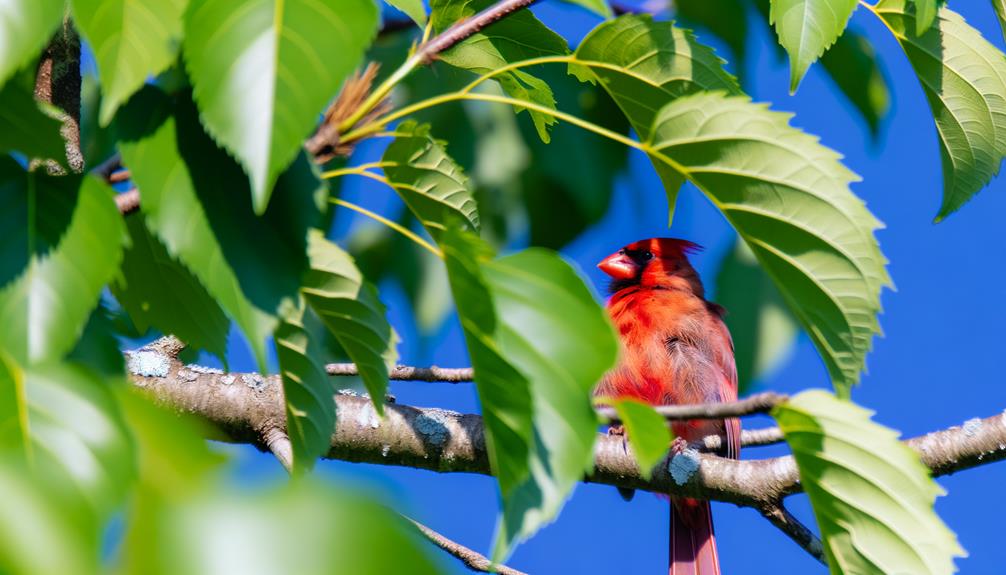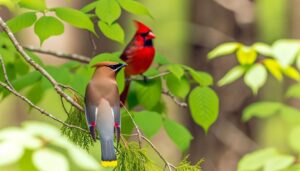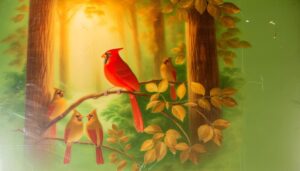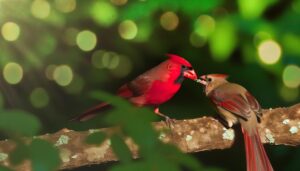How Do Male Cardinals Change Color?
Yes, male cardinals can change color. Their vibrant red plumage, driven by carotenoid pigments from their diet, can fluctuate.
Seasonal variations cause plumage to fade in winter due to reduced sunlight and lower carotenoid intake. During molting, they replace old feathers, leading to temporary dullness until new feathers grow.
Environmental factors, like habitat quality and pollution, also impact coloration. A diet rich in carotenoids, found in berries and seeds, enhances their red hue, indicating health and fitness.
Their striking appearance is a complex interplay of diet, environment, and seasonal changes, influencing their coloration throughout the year. Discover more intriguing details about their color variations.

Key Takeaways
- Male cardinals' plumage can fade slightly during winter due to reduced sunlight and dietary changes.
- Annual molting causes temporary dullness in male cardinals until new vibrant feathers grow back.
- Carotenoid-rich diets directly influence the intensity of male cardinals' red coloration.
- Environmental factors like pollution and habitat quality can lead to variations in color intensity.
- Seasonal color variations in male cardinals are adaptations to changing environmental conditions.
Male Cardinal Plumage Basics
Male cardinals showcase vibrant red plumage, which is primarily due to the carotenoid pigments they consume from their diet. You'll find that foods rich in carotenoids, like berries and seeds, directly influence the intensity of their coloration. Researchers have observed that males with access to a plentiful diet display more vivid red feathers, serving as an indicator of their overall health and fitness.
When examining these birds, you'll notice that their red hue isn't uniform; it varies slightly across individuals. This variation can be linked to differences in diet quality and absorption efficiency of carotenoids. By understanding these dietary impacts, you gain a clearer picture of how male cardinals maintain their striking appearance, essential for attracting mates and deterring rivals.
Seasonal Color Variations
Curiously, have you ever noticed how the red plumage of cardinals tends to fade slightly during winter months? This seasonal variation is subtle but observable. During winter, male cardinals' feathers can appear less vibrant due to the wear and tear from harsh weather conditions.
Scientific observations indicate that sunlight exposure, which is reduced in winter, plays a significant role in maintaining feather coloration. Data from ornithological studies show a correlation between sunlight intensity and plumage brightness.
Additionally, dietary changes in winter, such as lower intake of carotenoid-rich foods, can impact feather pigmentation. By understanding these environmental factors, you'll gain insight into the adaptive strategies of cardinals, ensuring their survival and reproductive success across different seasons.
Molting and Feather Renewal
When cardinals undergo molting, they replace their old, worn feathers with new ones, ensuring optimal insulation and vibrant coloration. Molting typically occurs once a year, often in late summer to early fall. This process is vital for maintaining the structural integrity and thermal regulation capabilities of the feathers.
Observational studies have shown that male cardinals, in particular, renew their bright red plumage during this period, which is essential for mating displays and territory defense. Feather renewal involves shedding old feathers in a staggered pattern to avoid significant loss of flight capabilities.
During this time, you might notice cardinals appearing less vibrant as new feathers grow in. Once molting completes, males regain their striking red color, showcasing their health and vigor.
Diet and Color Intensity
Often, the intensity of a cardinal's red plumage is directly influenced by its diet, particularly the intake of carotenoid-rich foods. Carotenoids, found in seeds, berries, and insects, are essential for vibrant coloration.
Studies show that males consuming higher carotenoid levels exhibit more brilliant red feathers. You might observe that cardinals in areas with abundant carotenoid sources display richer hues compared to those in regions with limited availability.
Research indicates that dietary variations can account for up to 30% of color intensity differences. By ensuring a carotenoid-rich diet, these birds not only enhance their visual appeal but also potentially improve their health and reproductive success, as vivid plumage often attracts more mates.
Environmental Influences on Color
In addition to diet, environmental factors such as habitat quality, pollution levels, and climate conditions greatly impact the coloration of male cardinals.
For instance, cardinals residing in urban areas often exhibit duller plumage compared to their rural counterparts. Pollution can degrade feather pigments, leading to less vibrant colors.
Habitat quality also plays an essential role; poor vegetation and limited resources can stress birds, affecting their overall health and color intensity.
Climate conditions further influence coloration. In harsher climates, cardinals may expend more energy on survival than on maintaining bright feathers.
Observational studies have shown that cardinals in best habitats with minimal pollution and favorable climates display more intense red hues, underscoring the significant role of environment in their coloration.
Conclusion
You've seen how male cardinals' plumage changes with seasons, molting, diet, and environment. Surprisingly, about 10% of male cardinals exhibit a rare, vividly bright red during the breeding season, making them more appealing to potential mates.
This vibrant hue results from a diet rich in carotenoids and ideal environmental conditions. Observing these changes with a keen eye reveals just how dynamic and responsive these birds are to their surroundings, reflecting a delicate interplay of biology and ecology.






